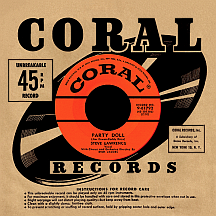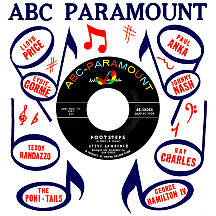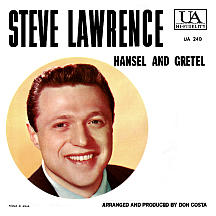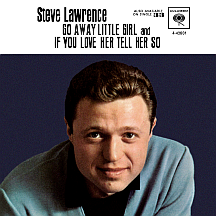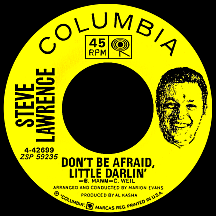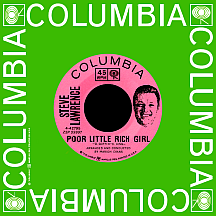STEVE LAWRENCE
When "Poinciana" became a hit for 16-year-old Steve Lawrence in the spring of 1952, it's doubtful he could have foreseen the busy six-decade-long career ahead of him. Even less likely would be the notion of spending nearly all of those years as a co-headliner with singing sensation and equal partner Eydie Gorme who, contrary to the expected showbiz norm, would also be his spouse for more than 55 years. The Steve and Eydie love story is one of celebritydom's best...and it comes with a memorable, hit-packed soundtrack!
Max Liebowitz led Jewish worship as a cantor in a Brooklyn synagogue. His son, Sidney Liebowitz, began singing at those services around age eight. Within a few years, Sidney was playing piano and saxophone and during high school he sang with the glee club. His older brother, Bernie, began working in the area as a singer and Sidney sometimes accompanied him on piano. Then Bernie got drafted and Sid decided it was his turn; his professional name came from a pair of nephews, Steven and Lawrence. After making himself known to the various publishing companies in New York, he got his first break: singing on demonstration recordings. This professional experience led to a spot on Arthur Godfrey's Talent Scouts, TV's top-rated program in 1951; he took first place and was signed to Cincinnati-based King Records in the spring of '52. "Poinciana," an exotic ballad composed in the mid-'30s by Nat Simon and Buddy Bernier, was revived in the film Dreamboat, starring Clifton Webb and Ginger Rogers, at about the time Steve's single hit the top 30. Demand for the teenage singer was so overwhelming that he dropped out of high school!
In June 1953, Steve Allen created the late night talk/comedy format as we know it with his Tonight! show broadcasts over N.Y.C.'s channel 4, WNBT. Lawrence tried out (along with about 50 others) and made the cut, as did Gorme, who parlayed the gig into a contract with Coral Records. The two were regulars on the show for the next five years, straight through Allen's promotion to the network in September '54 (kicking off the still-going-strong run of TV's nightly Tonight Show ritual) and move into prime time in '56 (in head-to-head competition with The Ed Sullivan Show on Sunday evenings). Steve also signed with Coral, sealing the deal with a late-'54 duet recording of "Make Yourself Comfortable" (billed as Eydie Gorme and Steve Lawrence), a hit at the time for both Sarah Vaughan and Peggy King. Gorme left for ABC-Paramount while Steve put together a string of hits at Coral, starting with a top 30 cover of "The Banana Boat Song," a Jamaican folk tune, performing respectably alongside versions by Vaughan, The Fontane Sisters, The Tarriers and the most famous version by Harry Belafonte.
Lawrence landed his first top ten hit in April 1957 with a pop cover of the chart-topping Buddy Knox hit "Party Doll" that unfortunately has not stood the test of time. Under the direction of arranger Dick Jacobs he reached the charts regularly in '57 and '58 with minor hits including "Can't Wait For Summer," by New York songwriters Diane Lampert and John Gluck, Jr.; the Coral recordings, while professionally produced, failed to showcase Steve's full potential...but he would have plenty of other chances to evolve as an artist. Perhaps he first needed to get his private life on track; despite her being seven years older, there was never anyone but Eydie (well, other than "gossip girl" Rona Barrett, who it's been rumored he took to the prom). So he married Miss Gorme on December 29, 1957. Several months later they hosted a summer replacement series, Steve Allen Presents the Steve Lawrence-Eydie Gorme Show. Immediately afterwards he was drafted and sent to Fort Myer, Virginia.
During his time in the service, Steve performed with the United States Army Band. In 1959 he joined his wife at ABC-Paramount, where she'd put together her own string of hits ("Too Close For Comfort," "Mama, Teach Me to Dance," "You Need Hands"). His label debut, Mac Curtis's adaptation of an Italian song, "(I Don't Care) Only Love Me," started things off nicely, but arranger Don Costa, who seemed to have a feel for trends in music at any given time, cast Steve as a teen heartthrob (after all, he was just in his early twenties...never mind that his "better half" had already hit the big 3-0!). Teddy Randazzo (same age as Steve) and Bobby Weinstein (even younger) wrote for the teen market...and out came "Pretty Blue Eyes," the kind of thing labelmate Paul Anka could sink his teeth into (except...well, Paul preferred to create his own material). In the final week of 1959, Steve was back in the top ten.
"Footsteps," a Barry Mann-Hank Hunter tune, had an effect similar to its predecessor and reprised the top ten feat; demand for Steve was strong, but his availability was limited as he completed his Armed Forces obligation. The Lawrence-Gorme team enjoyed making records separately and together; they began negotiating contracts in tandem, commencing with a late 1960 move to United Artists. Steve was able to continue working with Don Costa and "Girls, Girls, Girls," a Barry Mann-Howard Greenfield novelty, rattled off the names of recent hit females "Donna," "Peggy Sue," "Susie Darlin'," "Mary Lou" and '...all the ones that they have missed: Sheila, Shirley, Katherine, Tina, Lena, Madeline, ToniJoanieMaryJeanJanet...' and dozens more (some eventually getting their due in song). Maybe it was little over-the-top. Time to reset?
Matt Monro's career got off to a smashing start in early 1961 with "Portrait of My Love," penned by British songwriters Norman Newell (using the pseudonym David West) and Cyril Ornadel. Lawrence's U.S. cover yanked him out of the teen market and into the realm of romantic ballads when it went top ten in May '61. Its follow-up, "My Claire De Lune," a 1905 composition by forward-thinking French composer Claude Debussy, was enhanced with lyrics by (of all people) modern nonconformist songwriters Jerry Leiber and Mike Stoller (who obviously had a knack for love ballads). Steve's time at UA was brief; Eydie had no success there with a limited number of releases. That was okay; in early 1962 they jointly signed with Columbia Records. Steve struck first, defying expectations with a swingin' big band tune that latched onto the hottest of all dance crazes: "The Lady Wants to Twist." That summer he revealed another side to his talent set, guest-hosting The Tonight Show for a week during the down time between the Jack Paar and Johnny Carson eras. Then he caught the coattails of one of music's hottest songwriting teams as hubby and wifey entered their whirlwind hitmaking peak.
Gerry Goffin and Carole King, also a happily-married couple (well, for awhile longer, at least), had jump-started a string of hits when they secured the top spot with the fabulous "Will You Love Me Tomorrow" by The Shirelles. There were over a dozen top 40 hits over a two-year span including two more number ones, "Take Good Care of My Baby" by Bobby Vee and "The Loco-Motion" by Little Eva. They had written "Go Away Little Girl" with Vee in mind (totally makes sense!) but it ended up in Lawrence's lap. Producer Al Kasha employed a double-tracking technique used on several Columbia acts around that time; looks like it worked wonders. The record hit number one in January 1963.
Eydie's turn came next as Barry Mann and Cynthia Weil's "Blame it on the Bossa Nova" finally got her into the top ten. Steve followed with three youth-focused top 30 hits, Mann and Weil's "Don't Be Afraid, Little Darlin'" and Goffin-King songs "Poor Little Rich Girl" and "Walking Proud," all watermarked with the multitracking trick (as were Eydie's follow-up singles). The couple finally scored as a duo, credited as Steve and Eydie, with two more Goffin-King love sonatas, "I Want to Stay Here" and "I Can't Stop Talking About You." Separately and together they racked up a continuous, overlapping succession of nine chart singles in a little over twelve months.
The lovebirds' stars were on the rise in movies, stage productions and particularly on the tube. Steve took on some one-shot acting roles in TV series like Kraft Music Hall, Medical Center and a 1964 Rod Serling special, A Carol for Another Christmas. He starred on Broadway in What Makes Sammy Run? ("My Home Town" and "A Room Without Windows," by composer Ervin Drake, were among the show's 16 selections), for which he was nominated for a 1964 Tony award in the category Best Performance by a Leading Actor in a Musical. Chart singles of '64 and '65 included a dynamic tune from Frenchmen Charles Aznavour and Georges Garvarentz, "Yet...I Know" (with English lyrics by Don Raye) and Howard Greenfield and Jack Keller's theme from TV's hottest new comedy series, "Bewitched."
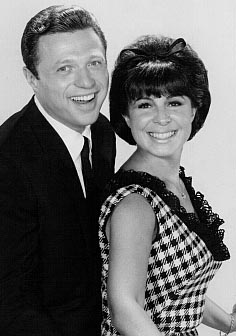
The Steve Lawrence Show premiered in September of '65 on CBS, an hourlong Monday evening variety series that was broadcast in black and white; TV Guide promised it would be in color in some point...and it was, several times, before an early cancellation near the end of the year. Another end came with Steve and Eydie's 1967 "Easy Listening" duet "The Honeymoon is Over"...and it was, as far as Columbia Records was concerned. They headed back to Broadway, together this time as co-stars of Golden Rainbow, which featured "I've Gotta Be Me," composed by Walter Marks, a top ten Easy Listening hit for Steve in early '68 and much bigger hit for Sammy Davis Jr. a year later. Steve and Eydie seemed to do a lot of material by husband-and-wife songwriting teams; one of these, British lovers Tony Hatch and Jackie Trent, recorded "The Two of Us" in 1967. Steve and Eydie's version for Calendar Records in '68 became their signature song, performed regularly throughout the years.
In 1971, Donny Osmond's juvenile take on "Go Away Little Girl" went to number one (the first time two versions of a song had reached the top since 1949, when Blue Barron and Russ Morgan pulled off back-to-back number ones with "Cruising Down the River"). Steve and Eydie got together with the Osmond clan in '72, hitting the charts with the feelgood "We Can Make it Together" on MGM. Steve just couldn't stop appearing on TV series episodes: Serling's Night Gallery in '71, Redd Foxx's Sanford and Son sitcom, cop drama Police Story and many others, a few dozen assorted roles over a 50-year span. A close friend and favorite guest of Carol Burnett, he made more than two dozen appearances on her CBS variety show throughout its eleven-year run, singing and doing comedy skits. Among a handful of theatrical films, he developed a following with his role in the infamous 1980 John Belushi-Dan Aykroyd comedy The Blues Brothers and its 1998 sequel, Blues Brothers 2000.
Steve and Eydie added an Emmy award apiece to their mantle, winning in the category Outstanding Comedy-Variety or Music Program for their August 1978 special Steve and Eydie Celebrate Irving Berlin, which also featured venerable entertainers Sammy Davis Jr., Carol Burnett and Bing Crosby. In 1979, a bit frustrated that radio hadn't played their records in several years, they released "Hallelujah" (by Israeli songwrtiers Schimrit Orr and Kubri Oshrat, not to be confused with several other songs that have the same title). The Warner/Curb single was credited to Parker and Penny; it received a smattering of airplay and made a brief appearance on Billboard's Adult Contemporary chart, an interesting experiment that failed. But in the long run it hardly mattered. Radio exposure was no longer essential to the collective career of Eydie Gorme and Steve Lawrence. I'm sure you've heard the phrase "America's Sweethearts," probably far too often. If any entertainers exist who definitively deserve such a heartfelt designation, they're the ones.
NOTABLE SINGLES:
- Poinciana - 1952
- How Many Stars Have to Shine - 1953
- Make Yourself Comfortable - 1954
by Eydie Gorme and Steve Lawrence - The Banana Boat Song - 1957
- Party Doll /
(The Bad Donkey) Pum-Pa-Lum - 1957 - Can't Wait For Summer /
Fabulous - 1957 - Fraulein - 1957
- Uh-Huh, Oh Yeah - 1958
- Many a Time - 1958
- (I Don't Care) Only Love Me - 1959
- Pretty Blue Eyes - 1959
- Footsteps - 1960
- Girls, Girls, Girls - 1960
- Portrait of My Love - 1961
- My Claire De Lune /
In Time - 1961 - Somewhere Along the Way - 1961
- Our Concerto - 1962
- The Lady Wants to Twist - 1962
- Go Away Little Girl - 1962
- Don't Be Afraid, Little Darlin' - 1963
- Poor Little Rich Girl /
More - 1963 - I Want to Stay Here - 1963
by Steve and Eydie - Walking Proud - 1963
- I Can't Stop Talking About You - 1963
by Steve and Eydie - My Home Town /
A Room Without Windows - 1964 - Everybody Knows - 1964
- Yet...I Know (Et Pourtant) - 1964
- Bewitched - 1965
- Millions of Roses - 1965
- The Honeymoon is Over - 1967
by Steve Lawrence and Eydie Gorme - I've Gotta Be Me - 1967
- The Two of Us - 1968
by Steve Lawrence and Eydie Gorme - Real True Lovin' - 1969
by Steve and Eydie - The Drifter - 1969
- We Can Make it Together - 1972
by Steve and Eydie featuring the Osmonds - Now That We're in Love - 1975
- Hallelujah - 1979
by Parker and Penny


